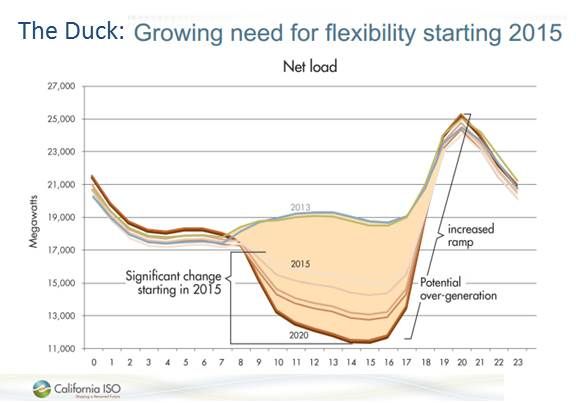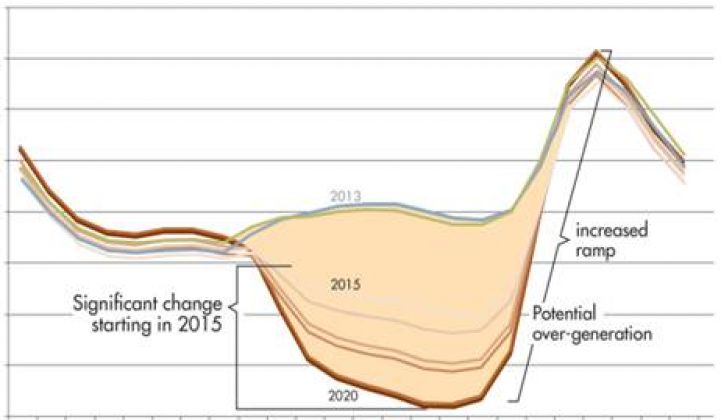California’s 33-percent-renewables-by-2020 mandate is becoming a reality, and the state’s electricity system operator wants the geothermal industry to help keep the grid stable as more generation comes from variable resources.
By 2020, due largely to solar, a graph of the change caused by variable renewables in the state’s grid ramping up will look like a duck, California Independent System Operator VP Karen Edson told industry leaders at the Geothermal Energy Association National Geothermal Summit.

Instead of the present maximum ramp in demand from 19,000 megawatts to 25,000 megawatts, Edson said, the ISO could need the capability to ramp from 11,000 megawatts to 25,000 megawatts by 2020.
The biggest needs will come in what Edson called the "shoulder months," when excess wind and hydro create overcapacity and early sunsets cause solar generation to drop off before peak evening demand periods end.
“I know it is easier to turn things on and let them run, and there are complications about how you manage your steam,” Edson said. “But to the extent you can help with that upward ramp and that downward ramp, it could be of great value.”
According to the most recent California Public Utilities Commission report, the state’s investor-owned utilities have built or contracted for their mandated renewables requirements, Edson said, and procurement for geothermal is predicted to fall faster and further than that for wind or solar. “The 2011 ISO interconnection queue had about 1,300 megawatts of geothermal,” she said. “Today we are down to 144 megawatts.”

"But geothermal has the ability to move in response to conditions and provide system operators with flexibility,” Edson said. “This industry needs to rethink its baseload generation model.”
“Building a geothermal project so that it can offer flexibility and ancillary services does not impose a significant cost, nor does it prevent a facility from being used as baseload when needed,” according to Paul Thomsen, Ormat Technologies Policy and Business Director. What is needed, he said, is to restructure procurement incentives.
“We know it is about the economics,” Edson told the geothermal leaders. The ISO has advocated for a flexibility requirement as part of California’s resource adequacy program. And its market mechanisms are designed to drive the investor-owned utilities and other load-serving entities (LSEs) toward procuring more geothermal.
The ISO wants the cost of flexibility to be allocated to LSEs based on their resource mix. “We have a number of utilities that are not contributing to the duck,” Edson explained. But requiring those LSEs with large variable generation portfolios to procure flexible generation should drive the growth of geothermal.
“We have negative pricing in our market. We will pay you to reduce your level or stop producing. If you want to hold for the ramp, the ISO would be happy to see that kind of flexibility coming from this industry.”
By 2015, she said, the flexibility geothermal potentially offers will be “essential for us.”
Edson acknowledged that for geothermal facility operators, it is a complicated question of opportunity costs. Having the ability to ramp up means holding back generation -- and that means foregoing revenue.
“We have mechanisms through our market systems,” Edson said. “I want you to examine those opportunities and think hard about providing more capability to the system.”
“The challenge for geothermal developers,” Thomsen noted, “is to extract enough value from the capacity, ancillary services, and flexibility attributes to compensate for the decline in energy attribute revenues.”




